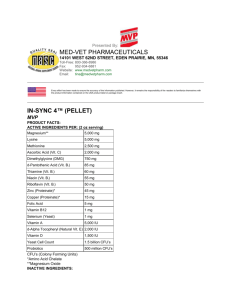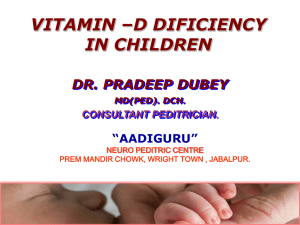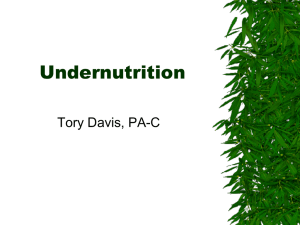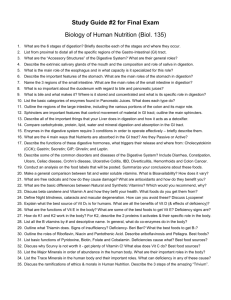Nutiriton
advertisement
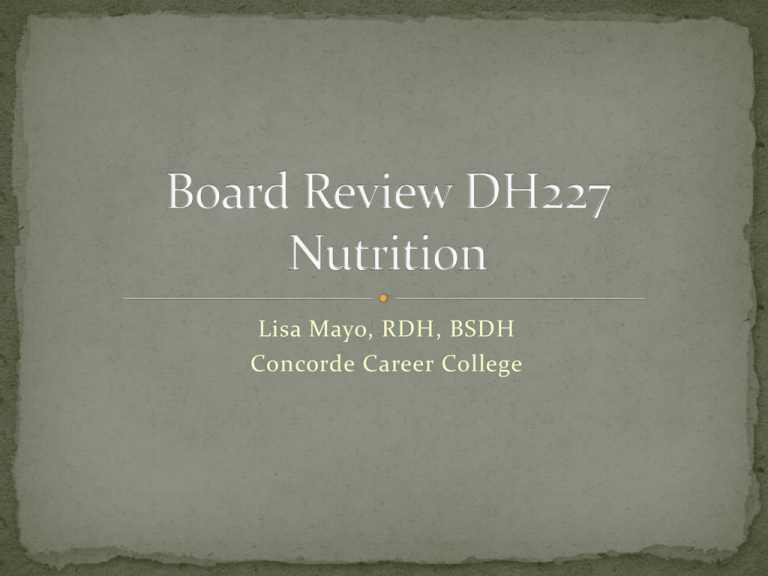
Lisa Mayo, RDH, BSDH Concorde Career College CHO Lipids PRO Vitamins Minerals Water Organic compounds made of carbon, hydrogen, oxygen Provide energy most abundant during metabolism Yield 4kilocalories/gram Monosacchies: Single Sugars. (glucose, fructose, galactose) Disaccharides: Double Sugars (sucrose, lactose, maltose) Polysaccharides: Complex. (starch, glycogen, cellulose, dextrans) 55-65% diet Digestion & Absorption Review overall summary: little digestion in mouth salivary amylase Know absorption routes 1. Capillaries – bl stream. Water soluble nutrients 2. Lacteals – bl stream. Fat soluble nutrients Monosaccharides Glucose: blood sugar/dextrose 1. Main fuel for brain and needed for RBCs Body uses this form best Sources include many foods, such as grapes, oranges, corn, carrots Fructose: levulose/fruit sugar 2. Sweetest of all sugars Sources include fruits, honey, corn syrup Galactose: component of milk sugar 3. Body converts glucose to galactose in mammary tissue during lactation – makes lactose in breast milk Sources include milk/dairy products Disaccharides 1. Sucrose (table sugar) 2. Lactose (milk sugar) 3. Furnish 1/3 of total COH intake in the average Western diet made of glucose and fructose Sources include sugar beets, sugarcane or maple syrup, fruits and vegetables Made up of glucose and galactose Sources include milk products Maltose (plant sugar) Made up of 2 glucose molecules Forms as a starch in grains Polysaccharides 1. Starch Plant storage form of glucose (amylase and amylopectin) Nutritionally most important CHO Digestible/breaks down at as low rate Stores energy Sources include rice, potatoes, pasta and legumes 2. Glycogen Provides 12-24 hours of stored energy Animal equivalent of starch Provides a food storage system in animal/humans (glycogenesis) In liver, it regulates blood sugar for the brain In muscle, it serves as an energy source for muscle contraction Not significant as a food course Polysaccharides 1. Dextrans 2. An energy source for caries-producing bacteria, such as S.mutans Fibers Should consume 20-35g/day Dietary: cellulose/hemicellulose: good source of fiber – found in bran, legumes, and all vegetables. Not digestible in water Functional: added to foods and dissolves in water to form a gel (sources include legumes, apples, cabbage) Total fiber: sum of dietary and functional fibers Blood Glucose Regulation 1. 2. 3. Glycogenesis: glucose stored as glycogen Glycogenolysis: glycogen broken down to glucose Gluconeogenesis: glucose synthesized from non-CHO **Will review in BIOCHEM slides** Hormones 1. Insulin 2. Released in response to high bl sugar from pancreases Bcells. Increase glucogenesis in liver and muscle cells also promotes fat storage Glucagon Released in response to low bl sugar from pancreas A-cells. Stimulates glucogenolysis in liver also gluconeogenesis 3. Epinephrine 4. Produced in adrenal glands in response to fight or flight Promotes glycogenolysis in muscle and some liver cells Kidneys Glucose spills into urine if excessive Digestion: digestive enzymes come from pancreas and cells of intestinal walls 1. Polysaccharides (Starch) 2. Disaccharides (SLM) 3. Initial digestion begins in the mouth will enzyme salivary amylase (breaks down into maltose) Digestion occurs in the walls of the small intestine Sucrose: enzyme sucrose breaks down sucrose into glucose and fructose Lactose: enzyme lactase breaks down lactose into glucose and galactose Maltose: enzyme maltase breaks down maltose into 2 molecules of glucose Monosaccharides: enter capillaries and glucose goes into blood to be used as energy Functions Provide energy (4kcal/gram) Needed for the brain and RBCs Spare PRO – PRO can supply energy, however its main function is to build tissue and replace cells (ie:growth) Aid in the oxidation (burning) of fats to prevent ketosis Furnish fiber for normal peristalsis Dietary requirement and nutrient sources – 130g per day, easy to obtain Carbohydrates may be clinically defined as a. Polyhydroxyl aldehydes b. Polyhydroxyl ketones c. Compounds with carbon, hydrogen, oxygen as a ratio of 1:2:1 d. None of the above e. All of the above Carbohydrates may be clinically defined as a. Polyhydroxyl aldehydes b. Polyhydroxyl ketones c. Compounds with carbon, hydrogen, oxygen as a ratio of 1:2:1 d. None of the above e. All of the above Question Which of the following complex carbohydrates (CHO) CANNOT be digested by humans? a. Starch b. Glycogen c. Amylose d. Cellulose Answer Which of the following complex carbohydrates (CHO) CANNOT be digested by humans? a. Starch b. Glycogen c. Amylose d. Cellulose Question Which of the following is (are) an important site(s) for CHO digestion? a. Mouth b. Stomach c. Small intestine d. A and B e. B and C Answer Which of the following is (are) an important site(s) for CHO digestion? a. Mouth b. Stomach c. Small intestine d. A and B e. B and C Artificial Sweeteners: nonnutritive sweeteners, non- CHO and non-caloric 1. Aspartame Active ingredient in NutraSweet and Equal Composed of 2 aa aspartate acid, phenylalanine, methanol Not stable in heat therefore not suitable for cooking; used in beverages and chewing gum Adverse effects – headaches, dizziness, and seizures Provide calories, but little is needed for sweeting 200 times sweeter than sucrose Not recommended of epileptics or pt’s with PKU 4kcal/g Artificial Sweeteners: nonnutritive sweeteners, non-CHO and non-caloric 2. Saccharin 2. 3. 4. 3. Active ingredient in Sweet-n-Low Used in soft drinks and table sweeteners, 300 time sweeter than sucrose Promoter (not a cause) of cancer tumor development. Zero kcal/g Acesulfame-K, 2. 3. 4. 5. Active ingredient in Sunette and Sweet One Stable in heat Used in gums, creamers, gelatin products 200 sweeter than sucrose Sucralose 4. Active ingredient in Splenda Stable in heat 600 times sweeter than sucrose Sucralose made from sugar. Made by chlorinating sucrose. Artificial Sweeteners: nonnutritive sweeteners, non- CHO and non-caloric 5. Neotame 2. 3. 4. 5. 6. Approved in 2002 by FDA Often blended with other sweeteners No amino acids are absorbed – therefore does not need to carry PKU warning Stable in heat 8000 times sweeter than sucrose – little is needed Sugar Alcohols Sorbitol: made from glucose Mannitol: made from mannose and galactose Xylitol: derived from cellulose products, such as wood straw and pulp cane 5 carbon sugar alcohol (polyol); sucrose is a 6-carbon sugar Absorbed slowly and completely from the small intestines – little or no insulin is metabolized during the absorption process Antimicrobial – S.mutans are attracted to xylitol over other sugars; however, the bacteria cannot metabolize xylitol and therefore die Nutritive sweeteners, CHO, sugar-like compounds that provide calories Do not promote tooth decay because they metabolize at a slower rate Not readily absorbed by small intestine, therefore can cause diarrhea Not metabolized by oral bacteria so considered non-cariogenic 4kcal/g The main function of CHO is to: a. Repair body tissues b. Neutralize acids and bases c. Provide energy d. Regulate metabolism The main function of CHO is to: a. Repair body tissues b. Neutralize acids and bases c. Provide energy d. Regulate metabolism CHO can be stored in the liver and muscle as: a. Lipids b. Fiber c. PRO d. Glucose e. Glycogen CHO can be stored in the liver and muscle as: a. Lipids b. Fiber c. PRO d. Glucose e. Glycogen Carcinogenicity of sugar containing foods 1. Increases when sweets are in liquid form 2. Increases with frequency intake 3. Decrease when eaten with non-cariogenic foods 4. Decreases if sucrose is replaced by honey and baked goods a. 1,2 b. 2,3 c. 2,4 d. 3,4 Carcinogenicity of sugar containing foods 1. Increases when sweets are in liquid form 2. Increases with frequency intake 3. Decrease when eaten with non-cariogenic foods 4. Decreases if sucrose is replaced by honey and baked goods a. 1,2 b. 2,3 c. 2,4 d. 3,4 Organic compounds composed of carbon, hydrogen, oxygen Triglycerides account for 95% of all lipids (fats and oils) 1. Triglycerides 3 fatty acids with glycerol backbone Includes saturated (no double bonds) and unsaturated (mono/poly unsaturated) 2. Phospholipids Includes lecithins and are part of lypoPRO VLDL, LDL, HDL, Chylonicons 3. Sterols Cholesterol is the most well know 1. 2. Saturated fatty acids Less than 10% total calories needed Carry minimum number of hydrogen atoms (hydrogenation) Remain solid at room temperature Increase serum cholesterol levels Sources include beef, lard, animal fats Monounsaturated fatty acids Less than 10% total calories needed Contain a point of unsaturation linkage (double bond) with no hydrogen atom Viscous in form Maintain serum cholesterol levels Sources include canola and olive oils 3. 4. Polyunsaturated fatty acids No more than 10% of total calories needed Contain 2 or more points of unsaturation (double bond) Liquid in consistency Decrease serum cholesterol levels Sources include vegetable oils Essential fatty acids (NBQ) Must be obtained from diet Linoleic: Omega-6. Sources: vegetable oils, sunflower and safflower Linolenic: Omega-3. Sources: fish, mackerel, tuna, salmon, plant oils, canola, olive, peanut Provide concentrated source of energy – 9kcal/g Provide insulation to maintain body temperature and protect organs Carry fat-soluble vitamins A,D,E,K Provide satiety (fullness) Provide flavor and texture to foods Fat-soluble Will not dissolve in water. Must be carried by lipoPRO carriers Food Sources Saturated: hard when cold except tropical oils Mostly animal sources Mono: canola oil, peanuts, olive oil Poly: corn oil, safflower oil, fish, margarine LioPRO Carriers HDL: take un-needed CHO back to liver LDL: deliver CHO to all cells in the body Chylomicrons: dietary triglycerides. Compromise bulk of carriers in our system VLDL: takes triglycerides manufactured from excess CHOs to fat cells for deposit as fat Lipids provide a. essential aa b. essential fatty acids c. vit C d. sodium Lipids provide a. essential aa b. essential fatty acids c. vit C d. sodium Question Which of the following organs is(are) important for the digestion of fat? a. Pancreas b. Stomach c. Gall bladder d. Intestinal mucosa e. All of the above Answer Which of the following organs is(are) important for the digestion of fat? a. Pancreas b. Stomach c. Gall bladder d. Intestinal mucosa e. All of the above Question Which of the following statements is true about essential fatty acids? a. b. c. d. Are linoleic and linolenic in humans Should compose about 20% of total kcal A and B A and C Answer Which of the following statements is true about essential fatty acids? a. b. c. d. Are linoleic and linolenic in humans Should compose about 20% of total kcal A and B A and C Made of many amino acids (aa) linked together by peptide bonds: linkage of amine grp and carboxy Contain the elements carbon, hydrogen, oxygen, nitrogen (sometimes sulfur) Main function = repair/build tissue Structure unique among other nutrients because contains Nitrogen Yield 4kcal/g Essential (Indispensable) aa – body cannot synthesize, must obtain from the diet, 9 are essential PVT MY HILL (acronym) Phenylalanine, Valine, Threonine, Methionine, Tyrptophan, Histidine, Isoleucine, Leucine, Lysine Nonessentail (Dispensable) aa- body synthesizes as long as nitrogen is present, not required in the diet (11 of them) Complete PRO (High Quality) Foods that contain all 9 aa Sources: animal foods (fish, meat, eggs, cheese, milk, soybeans) Incomplete PRO (Low Quality) Lack 1 or more essential aa (Plant PRO) Complementary PRO Need to combine 2 or more PRO to compensate for deficiencies in aa content Use of whole grains is important Physiology begins in the stomach Functions 1. 2. 3. 4. 5. 6. 7. 8. 9. Structure Enzymes Hormones Antibodies Blood clotting PRO carriers Fluid balance pH balance Energy – always last resort Sources and RDA (recommended dietary allowances) Animal: egg, vegetables, legumes, rice, grains PRO is the only fuel with an RDA. 8g/8kg body weight Dietary guidelines: 12% daily cal come from PRO Vegetarians: Lacto-ovo veg: People who include milk/milk products and eggs but exclude meat, poultry, fish, seafood Lactoveg: People who include milk and milkproducts but exclude meats, poultry, fish/seafood and eggs Vegan: excludes all animal derived foods including meats, poultry, fish, eggs and dairy products. Also called pure-vegetarians because they eat only plants 1. 2. Phenylketonuria: PKU -Liver cannot metabolize essential aa phenylalanine into non-essential aa tyrosine -Diet must restrict phenylalanine and avoid nutra-sweet PRO-Malnutrition or PCM Kwashiorkor: severe PRO deficient manifests itself with severe wasting of body fat. Edema in legs and abdomen Marasmus: Prolonged Inadequate Food Intake, and/or Deficiency in PRO-cal (starvation) Muscle waste and weaken and no edema Water Soluble: B, C Fat Soluble: A, D, E, K Organic nutrients needed by the body in small quantities Do not contribute energy to the body bur are needed as facilitators of body processes Fat-soluble Vitamins Soluble in fats and fat solvent Not readily excreted and therefore can build up to toxic levels Stored in liver and fatty tissues Water-soluble Vitamins Include all B,C vitamins Easily absorbed and excreted, therefore, it is unlikely to reach toxic levels Main functions include metabolism of CHO, fats, PRO, blood formation (hemopoiesis) Deficiency of these vitamins affects the mouth (cheilosis and glossitis) 1. Vitamin A Prevents night blindness, maintain normal mucous membranes Sources 1. Retinols: Preformed vit A. Found in animal foods such as liver, fish, fortified milk 2. Caritinoids: Vitamin precursors. Found in orange-yellow and dark green vegetables and fruits 2. Vitamin D Function as a hormone Sources: sunlight, fortified milk, fish liver oils Nutritional Deficiency and Disease 1. Rickets: in kids, softenng of bones due to failure to calcify normally. Symptoms include bowed legs, enlarged head/joints/rib cage, deformed pelvis 2. Osteomalacia: adults, calcium is taken from bones to make up for insufficient absorption in intestine. Symptoms include bowed legs, bent posture and pain in ribs/pelvis/legs Assists as 1. Absorption of calcium and phosphorus 2. Formation and mineralization of teeth and bones 3. Vitamin E Tocopherol – tool in the battle against cancer and heart attack Function: preserves fats (antioxidants) Sources: vegetable oils, green leafy vegetables, whole grains Toxicity: interferes with blood coagulation vit K 4. Vitamin K Function: aids in the formation of blood-clotting factor prothrombin and helps increase bone density Sources: green leafy vegetables, synthesized by intestine Which of the following vit interferes with the action of vit K? a. C b. E c. D d. B1 Which of the following vit interferes with the action of vit K? a. C b. E c. D d. B1 Vitamin Functions Deficiencies Sources Properties A Normal vision, PRO synthesis, helps remold bone Night blindness, imapired tooth formation, keratinized epithelial tissues Retinols-animal sources, Caritinoids (deep yellow-orange, dark-green veg & fruits) Found in preformed (active) vit A & provit A D Bone growth w/the assistance of Ca & Phosphorus Rickets, osteomalacia, osteoporosis, Cadeficiency Sun, fortified milk & products E Antioxidant Rare Found in many foods including polyunsaturated veg oils K Clots blood Hemorrhaging Bacteria in GI, liver, cabbage, leafy green veg Easily destroyed by heat & exposure to air, toxicity interferes w/blood coagulation Question Characteristics of fat-soluble vitamins include all of the following EXCEPT: a. Contain carbon, hydrogen, oxygen b. Must be emulsified before they can be absorbed from the diet c. Deficiency symptoms are slow to develop d. Unstable to light, heat, oxygen e. Toxic with chronic excessive intake Answer Characteristics of fat-soluble vitamins include all of the following EXCEPT: a. Contain carbon, hydrogen, oxygen b. Must be emulsified before they can be absorbed from the diet c. Deficiency symptoms are slow to develop d. Unstable to light, heat, oxygen e. Toxic with chronic excessive intake 1. Thiamin (B1) Function: helps provide energy to brain, heart, CNS Nutritional Deficiency and Disease: Beri-Beri which damages nervous and cardiovascular systems Sources: pork, enriched whole grains, legumes, milk, nuts, peas 2. Riboflavin (B2) Function: essential for growth and production of RBC, prevents cheilosis, glossitis, anemia Sources: milk, green leafy veg, legumes Properties: sensitive to light (milk should be stored in cardboard/opaque containers) 3. Niacin (B3) Function: needed in RNA and DNA synthesis Nutritional Deficiency and Disease Pellagra Rough, painful skin Dementia Diarrhea Dermatitis Death Sources: meat, fish, enriched grains, green leafy veg Properties: aa tryptophan can be converted to niacin 4. Folate (Foclain, Folic acid) Function: assists in forming DNA, RNA and RBC formation Nutritional Deficiency and Disease Megaloblastic anemia Glossitis Diarrhea Birth defects (spina bifida) Sources: liver, dark green and leafy veg, OJ 5. Cobalamin (Cyanocobalamin B12) Function: helps build tissues, maintain nerve cells, essentail for RBC development, also needed for folate metabolism Nutritional Def and Disease: found in strict vegetarians, pernicious anemia (weakness, sore tongue, apathy) Sources: animal or fortified foods Properties Intrinsic factor: PRO made in stomach, needed for absorption of B12 Extrinsic factor: must be obtained through foods 6. Vitamin C (Ascorbic Acid) Functions: promotes synthesis of PRO collagen (ct), acts as an antioxidant Nutritional Def and Disease: Scurvy: ruptured blood vessels, swollen and bleeding gingiva, delayed wound healing Sources: strawberries, broccoli, cantaloupe, citrus fruits, potatoes, tomatoes Properties: no extensive storage, smoker and women on BC pills have increased need Vitamin Function Deficiencies Sources Thiamin (B1) Energy to brain, heart, CNS BeriBeri Pork, enriched grains, milk, legumes, nuts Riboflavin (B2) Growth, repair, prod. RBCs Cheilosis, glossitis, fatigue Milk, enriched grains, eggs, poultry, fish, nuts, legumes Niacin (B3) RNA/DNA synthesis & metabolism Pellegra Meat, enriched grains, legumes, yogurt Pantothenic Acid Coenzyme in energy metabolism Rare Many foods Biotin Coenzyme in energy metabolism, glycogen synthesis Rare Cauliflower, cooked eggs, peanut, cheese Properties Amino acid tryptophan can convert to niacin Vitamin Function Deficiencies Sources Properties Pyridoxine (B6) Brain function, prod of RBCs Irritability, depression, muscle weakness, anemia Meat, poutltry, fish, bananas, white/sweet potatoes Folate Helps form DNA/RNA/RBC Megaloblastic anemia Spina Bifida Dark green leafy vegetable, orange juice Need more if on birth control Cobalamin (B12) Builds tissues, develops RBCs Pernicious anemia Sore tongue Animal foods Fortified foods Lack of intrinsic /extrinsic factor Vitamin C Synthesis of PRO collagen, antioxidant, wound healing Scurvy Fruits, vegetables, fortified foods Smokers Need more if on birth control Question Which of the following is a general function of water soluble vitamins? a. Function as coenzymes for energy metabolism b. Are important for vision c. Are important for regulating Ca levels in the body d. Are important for normal blood clotting e. Function to maintain epithelial cells and mucosal lining Answer Which of the following is a general function of water soluble vitamins? a. Function as coenzymes for energy metabolism b. Are important for vision c. Are important for regulating Ca levels in the body d. Are important for normal blood clotting e. Function to maintain epithelial cells and mucosal lining Inorganic nutrient used in the body for building and regulating functions Yield no energy to the body, but assist in regulating the release of energy Macrominerals Major minerals present in amts greater than 5g in the body Calcium, Sodium Microminerals Required in the diet in amts <100mg/day Iron, Copper, Iodine, Zinc Functions Forms and maintains bones and teeth Coagulates blood Nutritional Deficiency & Disease Rickets Osteomalacia Osteoporosis Women at highest risk Sources Dairy products, broccoli, soy sources Calcium-fortified fruit drinks, calcium supplements Properties Contribute to HBP which can lead to heart disease, stroke Hypertension is not caused by excessive sodium but aggravates it Recommendations Reduce sodium intake and increase the use of spices wen cooking Function Helps manufacture amino acids and hormones Nutritional Deficiency and Disease Anemia Oral lesions Patchy tongue Brittle bones Fatigue Sources Organ meats (liver), dried beans, nuts Not found in milk Function Formation of hemoglobin Sources Shellfish, oysters, crab, liver, legumes Function Helps regulate BMR (thyroid gland) Nutritional Deficiency and Disease Goiter Function Wound healing Aids in cell and immune system function Nutritional Deficiency and Disease Skin disorders Properties Highest concentrations found in bones Sources Seafood, tofu, milk, eggs, whole-grain breads Diabetes Mellitus Metabolic disorder characterized by high blood glucose levels due to insufficient or ineffective insulin function When glucose levels are elevated in the blood and cells, tissue damage will result Normal glucose levels: 70-125mg/dl Type I or II Question The important nucleic acids that carry the genetic message for protein synthesis to the cytoplasm are a. DNA b. cDNA c. mRNA d. rRNA e. tRNA Answer The important nucleic acids that carry the genetic message for protein synthesis to the cytoplasm are a. DNA b. cDNA c. mRNA d. rRNA e. tRNA Type I Insulin-dependent (IDDM) Involves the minority of cases (5-10%) Occurs primarily in kids and young adults – 10-14yrs Islets of Langerhans in pancreas cannot synthesize insulin Onset assoc with a viral infection or hereditary Characterized by weight loss with increase appetite Type II Noninsulin-dependent (NIDDM) Most common (90%) Usually develops in people over 40yrs and is assoc w/obesity Results from insufficient insulin or improper use Characterized by weight gain and increased apatite Signs and Symptoms Hyperglycemia: abnormally high blood glucose concentration Acetone breath: fruity odor as a result of ketosis Ketonemia: ketones in blood Ketonuria: ketones in urine Polydipsia: increased thirst Polyuria: frequent urination Polyphagia: increased appetite due to need for energy Chronic Complication Increase in periodontal disease – 3 times more likely to get perio disease, other infections Xerostomia - increase decay Blindness Poor circulation Heart disease – most frequent cause of diabetes-related death Loss kidney function Hypoglycemia Low blood glucose levels (brain almost entirely fueled by glucose) Less than 70mg/dl Symptoms: Shakiness Dizziness Sweating Heachaches Irritability Hunger Lightheadedness Palpitations (not lowered heart rate!) Motivation: motivate patient by Involve them in the decision making process Allow them to choose what should be eliminated from diet Allow them to be accountable for changing behaviors Diet Survey – evaluate Frequency of intake – worse times are between meals Consistency of food – physical form Amt of sugar added to foods Total intake Remember: lactic acid attack begins within the first min of exposure Question Which of the following is NOT a dietary recommendation for a diabetic? a. Eat a low complex CHO diet b. Limit fat intake to 30% of Kcal c. regulate CHO and meal spacing during the day d. Coordinate food intake, exercise, and medication e. Limit simple sugars Answer Which of the following is NOT a dietary recommendation for a diabetic? a. Eat a low complex CHO diet b. Limit fat intake to 30% of Kcal c. regulate CHO and meal spacing during the day d. Coordinate food intake, exercise, and medication e. Limit simple sugars Primary Under nutrition: env lack of adequate food Under-developed countries Secondary 1. 2. 3. 4. 5. 6. Altered Behaviors: Advanced malignant disease, Infection, Renal failure, Depression, Anorexia nervosa, Bulimia Obesity Disorders interfering with ingestion: Oropharyngeal disease/tumors, ulcerations, pain, neuralgia, neurological syndromes (palsies, myasthenia gravis), malocclusion, TMJ Defective absorption: Chron’s disease, organ failure, tropical sprue, celiac disease Excessive loss of nutrient: chronic blood loss (iron) Increased requirements: pregnancy, periods rapid growth Minerals: Iron, Ca, Iodine 2. PRO deficiency (next slide) 3. Hypovitaminoses 4. Hypervitaminoses 1. Kwashiorkor: not enough PRO Oral Manifestations 1. 2. 3. 4. 5. Glossal edema with scalloping of lateral margins Glossal papillary atrophy (dorsum is smooth and red) Angular cheilitis/fissuring Lip pigmentation Xerostomia , Saliaosis (enlarged salivary glands) 1. 2. 3. 4. 5. 6. 7. 8. 9. 10. 11. 12. 13. Constitutional symptoms: not feel good Angular cheilitis Atrophic glossitis: smooth bald, smooth patchy red Gingivitis Stomatitis: ulcerative, burning Vitamin C: ascorbic acid Vitamin B1: thiamine Vitamin B2: riboflavin Vitamin B5: niacin, nicotinic acid Vitamin B12: Cobalamin Folic acid Vitamin D Vitamin K Vitamin C Scurvy GI bleeds Petechiae hemorrhages Gingivitis, hyperplasia, bleeding Exaggerated perio d. Tongue normal Prevalence controversial except in fad diets Vitamin B1 Beriberi Peripheral neuropathy Cardiac disease Edema May have painful or burning tongue Oral symptoms unusual B2 Common in underdeveloped countries US: alcoholics Severe cold symptoms including sore throat Tongue may be sore, purple, pebbly B5 Pellegra Common Africa/Asia Gen edema and vesiculobullous lesions Severe glossitis, sometimes with severe stomatitis and gingivitis Glossal atrophy, glossal edema, glossal fissuring Combined riboflavin-niacin deficiency not as rare as other hypovitaminoses Vit B12 Pernicious anemia Nervous disorders Folic acid Part of clinical picture of sprue Atrophic tongue Bright red gingivitis Vitamin D Rickets: kids Octeomalacia: adults No basis for dental caries No clinical oral symptoms, may be radiographic signs (bone distortion) Vitamin K Blood clotting factors Severe symptoms Headache, fever GI: nausea, pain, vomiting, diarrhea, aggravation of peptic ulcers Itching, hay fever. Asthma-like symptoms (thiamine) Hypercholesterolemia (ascorbic acid) Kidney damage (Vit D) Swollen gingiva and capillary fragility are signs of possible deficiency of which of the following? a. Vit A b. Vit C c. Vit D d. Vit E e. Vit K Swollen gingiva and capillary fragility are signs of possible deficiency of which of the following? a. Vit A b. Vit C c. Vit D d. Vit E e. Vit K Which of the following is NOT an indicator in the oral tissues of possible nutritional problems? a. Dental caries b. Gingivitis c. Glossitis d. Cheilosis e. Xerostomia Which of the following is NOT an indicator in the oral tissues of possible nutritional problems? a. Dental caries b. Gingivitis c. Glossitis d. Cheilosis e. Xerostomia Which of the following is a major gland that affects BMR? a. Thyroid b. Pancreas c. Endocrine d. Hypothalamus A. Thyroid BMR: Basal Metabolic Rate. Measure of energy needed to maintain life at rest (breathing, heart beating, circulation, muscle tone and body temp) BMI: Body Mass Index: reflects weight in relation to height. Not a measure of lean body mass BMI: weight(kg) or weight(lb) x 705/Ht Vegans are at risk for developing deficiencies in which of the following nutrients? a. b. c. d. e. CHO vit B12 Protein Vit A Vit C Vegans are at risk for developing deficiencies in which of the following nutrients? a. b. c. d. e. CHO Vit B12 Protein Vit A Vit C Calories from food should equal energy needs of the body Energy needs of the body Basal metabolism rate (BMR): measure of energy needed to maintain life at rest Degree of physical activity: voluntary component of energy which varies from sedentary to strenuous activity Specific dynamic activity (SDA): energy required to digest and absorb foods Question Which of the following statements is true about the basal metabolic rate? a. Should be measured with a person sleeps b. Is influenced by climate and altitude c. Includes the energy necessary for normal muscle activity d. Includes the specific dynamic energy (SDE) e. Should be measured at an environmental temperature of 98.6 degrees Answer Which of the following statements is true about the basal metabolic rate? a. Should be measured with a person sleeps b. Is influenced by climate and altitude c. Includes the energy necessary for normal muscle activity d. Includes the specific dynamic energy (SDE) e. Should be measured at an environmental temperature of 98.6 degrees Self-starvation due to a distorted body image of being overweight Behavior Profile Female, occurs after puberty Competitive/obsessive behavior Increased risk with upper SES Family conflict, overbearing parents Fear of gaining weight Characteristics Dramatic weight loss (20-40%) below desirable body weight Excessive exercise, aversion to foods and altered eating habits Eats 300-600cal/day Amenorrhea, Lanugo (soft, fine hair) Decreased heart rate caused by slowing metabolism Tx Dietary, psychological, 50% who survive = 6 year recovery Episodes of binge eating followed by purging to prevent weight loss (vomit or laxatives) Behavior profile Female, college-aged student Weight is at or slightly above normal Turns to food for comfort, aware behavior is abnormal Low self-esteem and impulsive behavior Characteristics Vomits @ least 2x/wk Eats 15,000 or more cal in a binge Calluses on knuckles, depressed Tx Dietary, psychological Oral Manifestations Erosion, thermal sensitivity, enlarged parotid glands, cheilosis Recommend NaF rinses or sodium-bicarb rinses to neutralize acids Characteristics Consumes non-nutritive substances (soil, paper, coal, lead, paint chips) Abnormal apatite for things that may be considered foods (raw potatoes, ice cubes, flour) Causes Biochemical or iron deficiency Tx Psychosocial, environmental, family guidance approaches Question Which of the following statements is false about anorexia nervosa? a. A state of PRO-energy malnutrition b. More prevalent in females then males c. Treated with psychiatric and/or psychological counseling d More prevalent than bulimia e. Often seen in individuals descried as perfectionists Answer Which of the following statements is false about anorexia nervosa? a. A state of PRO-energy malnutrition b. More prevalent in females then males c. Treated with psychiatric and/or psychological counseling d More prevalent than bulimia e. Often seen in individuals descried as perfectionists Twice as many people have Bulemia, anorexia more discussed in media
